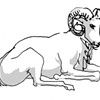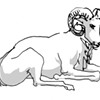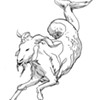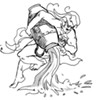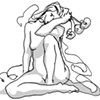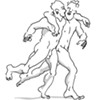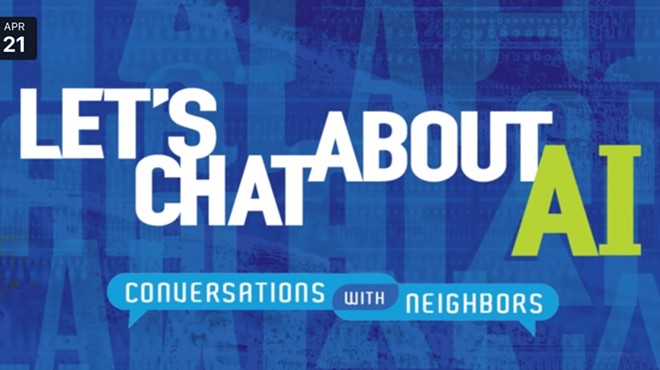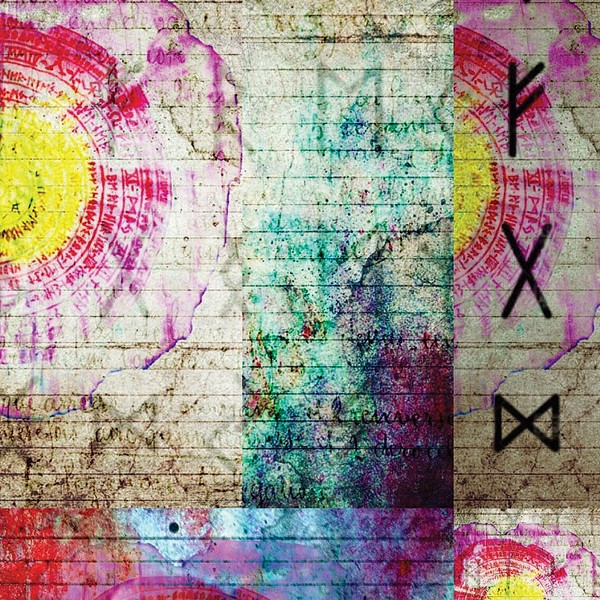Spring 2012: The Deep Background
[]
By now you may be familiar with some elements of the astrology of the (Northern Hemisphere) spring of 2012—a pair of eclipses in Gemini and Sagittarius, Venus stationing retrograde, and the Venus transit of the Sun on June 5. These events lead us into the first exact meeting of Uranus and Pluto in a square aspect—the Uranus-Pluto square, just past the solstice on June 24.
These all arrive in a close sequence, and when that happens, the pace of existence picks up. Most of these are eclipse-like events, which emphasizes that sense of acceleration.
Here is a basic rundown of things you’re most likely to read about on the Internet or, who knows, maybe even in a magazine. Venus stations retrograde in Gemini on May 15. Venus is retrograde least of all the planets; this is pretty special. Five days later, the Sun enters Gemini and there’s an annular eclipse of the Sun on May 20. Two weeks later, we experience a partial eclipse of the Moon; that’s on June 4. Then within hours, the Moon makes an eclipse to Pluto (one of many this year).
Very little has been written about this series of Moon-Pluto events—called occultations. Few astrologers are even aware of the data. You have to go looking for it (and thanks to a close friend of mine in Wales, Tracy Delaney, there is a research tool for that at Serennu.com). I will come back to the Moon’s eclipses of Pluto in a few moments in the discussion of Pluto.
As mentioned, on the heels of a lunar eclipse and Pluto eclipse, on June 5 Venus passes between the Earth and the Sun. This is called a transit of Venus, which is visible with some basic equipment anywhere you can see the Sun when it’s happening (unfortunately, not most of the continental US). It’s a rare event; they come in pairs. This will be the second of the current pair, and then there won’t be another one until 2117.
Eclipse-like events typically arrive with a sense of acceleration of time and our movement in time. There’s an increase in this thing described as “intensity.” Events can have a karmic feeling: Everything seems more meaningful, but we don’t necessarily know what that meaning is, or where it comes from.
This, in turn, can come with the sensation that you are at a crux point in your life. “Crux” is an interesting word. It has its origins in the idea of “a point in a text that is impossible to interpret,” which you can take as something like a “crossroads of interpretations”—or something that has many meanings, with an accompanying sensation of importance. The modern meaning is “central point,” and we are indeed at the central point of 2012, when we will start to see why this year has received so much emphasis and prediction.
Once we get past the eclipses and the transit of Venus, we go right into the Uranus-Pluto square. This has been developing for years. It’s part of the “cycles of revolution” series of aspects. This particular cycle has its roots in an event in 1965-66, which sparked what we call The Sixties. That was a conjunction between Uranus and Pluto. Now, 47 years later, the planets are at 90 degrees to one another, which is called a square. Aspects between influential, slow-moving planets take many years to develop, and influence everyone in some way.
We’ve been feeling the effects since late 2008, and they have been undeniable beginning with Arab Spring, the Wisconsin protests and the Occupy movement. Activism is often one manifestation of Uranus-Pluto events, and astro-historians have documented that it can go as far as revolution. When we talk about a ‘power to the people’ kind of event, that has a liberal/liberationist flavor (à la Stephen Colbert’s definition, that reality has an inherently liberal bias—which is why there are so many conservatives).
What we’re seeing under this square, though, is a heck of a lot of conservative activism, meaning antiwoman, antisex and every new policy designed to cut taxes for the rich even more. Laws are being passed routinely that curtail civil rights; both “liberals” and “conservatives” should be equally concerned. This activism has a ghoulish, militant quality, and there is no way to reckon it with the increasingly elusive concept of “ethics.” Much of it is being done as a show of force, and also an unchecked indulgence in narcissism. Currently, much of politics is “all about me,” and this kind of self-obsession feeds right into the hands of the darker forces that are once again trying to consolidate their grip on what they think of as reality.
The militant quality of the equation comes from the Uranus in Aries side of the square. Aries is the ancient Roman god of war, associated with Mars (whose Greek name is Ares). Uranus in this sign is flashy, impressive and extremely distracting. It’s the “big show” aspect of the news right now, and there are indeed some people who are quite adept at screaming into the echo chamber. Watch them as they start to get cranked up on the astrology of the next eight weeks; you’ll recognize them by the slightly electrified look in their eyes, their hair standing up, and this odd feeling that they want to serve you as the main course at a pro-life banquet.
All of this flashy stuff is a kind of cover-up for something else—and that something can be described as Pluto in Capricorn. This is the other side of the Uranus-Pluto square. Pluto in Capricorn is a long transit—spanning from 2008 through 2024. We’re less than four years into this event, though it’s been long enough that we should be seeing some patterns.
Pluto is a potent, nearly invisible force. We feel it as obsession, inevitability, enforced growth, and the deep, urgent need to grow and become. Pluto is associated with Scorpio, and is a prime mover of sexual energy, which spans from the most instinctual level to the most spiritually evolved. It all depends on where you tune in (it’s a good idea to scan the full frequency range that Pluto represents, so you’re familiar with all of the different expressions; themes include sex, death, power, and fear). Nothing can stop the movement of Pluto, or its influences in the world. Anyone who has consciously gone through a Pluto transit can tell you this. It’s the kind of thing you have to work with, like a natural force. It’s not possible to stop an earthquake, though it is possible to plan for it.
Speaking of Earth, Pluto is in Capricorn. Capricorn contains the patterns of the past. It represents the structure of society, describing business and government, and the relationship between the two. It represents all things old. It’s a fiery earth sign, since it is cardinal—a tense dynamic which helps explain the energy of many people with strong chart elements in this sign.
In consciousness, Capricorn represents what we carry from the past—including with our ancestors (beginning with our parents) and going back for many generations. We rarely notice much of this material; however, it’s often what we feel trapped by. If you have strong Capricorn in your chart, you may be able to notice and work with it a little better; however, much of humanity is trapped in some version of the past.
Now, Pluto is in Capricorn, which is like a herd of goats getting into a museum. They’re going to take the place apart, munch on the exhibits, and lick the dinosaur bones. Well, it really goes deeper than that. This sense of the Earth shaking that we live with every day—that is Pluto in Capricorn. The feeling that civilization is being crushed under its own weight: Pluto in Capricorn. And the burning sense of urgency, coming from inside and not from any external excitement: also Pluto in Capricorn.
We can look at this transit a few ways. One way is as a subversive movement inside the halls of power. Since not much productive happens there, we can trust that Pluto is helping to free energy. Pluto is a kind of core vital force, working to rejuvenate all that has become too old, brittle, and useless. The movement to ban contraception and even outlaw premarital sex can be seen as reactions to the liberating nature of Pluto in Capricorn—these things are inherently reactions against vitality, as are all anti-sex movements. Yet deep beneath everything, something primal and natural is trying to set itself free in the human experience.
Now, I mentioned the occultation of Pluto by the Moon that happens just before the transit of Venus. This is the third of 19 events that started in April. The Moon passes directly over the disk of Pluto, blocking it out. Pluto is invisible unless you have a very good telescope, but we still feel the effects. The last time anything like this happened was between 1919 and 1934, when Pluto was in Cancer. So this series of events gets props for being both weird and rare.
Pluto is strong in Capricorn for many reasons. He is feeling good. But the Moon—the more she tries to resist, the more she finds herself giving in. She tries to deny (occult) him but in that moment they fuse; literally come together. When denying sexual feelings, the more you try the more you are overcome, and inevitably must let go into the beautiful surrender.
The Moon occulting Pluto feels like she’s trying to hide Pluto, which is fine with him. He wears the helmet of invisibility and functions quite well in the underworld—the unconscious, which is the source of all dreams and desires.
But hide with what? The Capricorn Moon is trying to put a veil of propriety over what is coming from the most instinctual, hormonal level. She thinks it’s better not to admit any of that stuff, and maintain her image as a good girl. At the same time, the relentless quality of the exact conjunction, repeating so many times, feels like something deep is trying to work out and work through one’s emotional body.
Perhaps that includes your mother’s emotional body that was imparted into you—as if some ancient emotional and sexual blockage is finally being softened and released. The Moon has to be “out of her element” (in the sign opposite her native Cancer) in order to experience this. It’s similar to a Chiron effect, where discomfort or inconvenience is used to foster something healing and positive.
In letting go, the pleasure of resistance (which we’re trained to love and worship) is released to another, deeper pleasure. The pleasure of resistance is (if you believe Freud) a product of pleasing other people with our self-control. Now, that whole thought form is being dissolved, or burned through, again and again.
Finally there is penetration, and that is another way of saying transformation—the thing that Pluto is most famous for. This is acting on emotional resistance, or the burden of overstructure, something that humans are most famous for. This can be terrifying to those whose whole notion of existence is about rigid personality armor, but the time is arriving to let it go. This may even seem to happen overnight, but if it does, you can be sure you were working at it for a long time.








